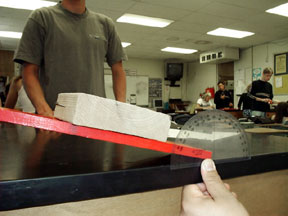Friction Vector lab




Repeat several trials to confirm you have the angle correct.
Report: Each student turns in their own page(s) Show all formulas and work.
a. Construct a diagram that shows the ramp, angle between the ramp and desktop, and the block. Draw in and label the force vectors representing the weight of the block, and the components of that weight that act parallel (Fa)and perpendicular to the ramp, the Normal Force and the Frictional Force:

b. Determine weight, Fg, of each block, and the component of that weight that is parallel to the ramp (Fa), and the component that is perpendicular to the ramp.
c. Calculate the coefficient of sliding friction for each block.
d. Make a free-body diagram for each block.